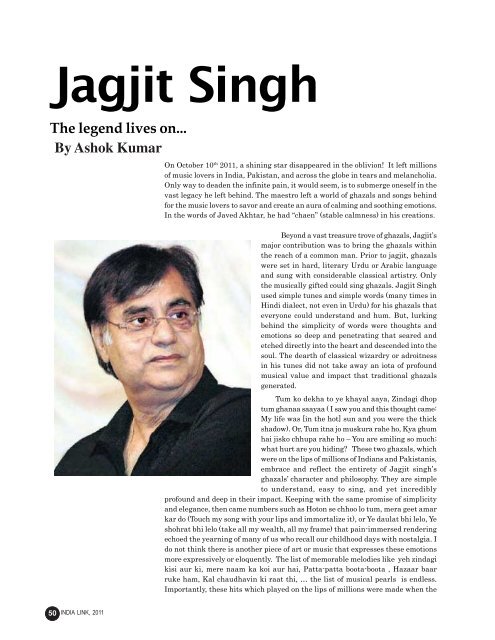6.00 pm Cultural Program - India-Link.org
6.00 pm Cultural Program - India-Link.org
6.00 pm Cultural Program - India-Link.org
Create successful ePaper yourself
Turn your PDF publications into a flip-book with our unique Google optimized e-Paper software.
Jagjit Singh<br />
The legend lives on...<br />
By Ashok Kumar<br />
50 INDIA LINK, 2011<br />
On October 10 th 2011, a shining star disappeared in the oblivion! It left millions<br />
of music lovers in <strong>India</strong>, Pakistan, and across the globe in tears and melancholia.<br />
Only way to deaden the infinite pain, it would seem, is to submerge oneself in the<br />
vast legacy he left behind. The maestro left a world of ghazals and songs behind<br />
for the music lovers to savor and create an aura of calming and soothing emotions.<br />
In the words of Javed Akhtar, he had “chaen” (stable calmness) in his creations.<br />
Beyond a vast treasure trove of ghazals, Jagjit’s<br />
major contribution was to bring the ghazals within<br />
the reach of a common man. Prior to jagjit, ghazals<br />
were set in hard, literary Urdu or Arabic language<br />
and sung with considerable classical artistry. Only<br />
the musically gifted could sing ghazals. Jagjit Singh<br />
used simple tunes and simple words (many times in<br />
Hindi dialect, not even in Urdu) for his ghazals that<br />
everyone could understand and hum. But, lurking<br />
behind the simplicity of words were thoughts and<br />
emotions so deep and penetrating that seared and<br />
etched directly into the heart and descended into the<br />
soul. The dearth of classical wizardry or adroitness<br />
in his tunes did not take away an iota of profound<br />
musical value and impact that traditional ghazals<br />
generated.<br />
Tum ko dekha to ye khayal aaya, Zindagi dhop<br />
tum ghanaa saayaa ( I saw you and this thought came:<br />
My life was [in the hot] sun and you were the thick<br />
shadow). Or, Tum itna jo muskura rahe ho, Kya ghum<br />
hai jisko chhupa rahe ho – You are smiling so much;<br />
what hurt are you hiding? These two ghazals, which<br />
were on the lips of millions of <strong>India</strong>ns and Pakistanis,<br />
embrace and reflect the entirety of Jagjit singh’s<br />
ghazals’ character and philosophy. They are simple<br />
to understand, easy to sing, and yet incredibly<br />
profound and deep in their impact. Keeping with the same promise of simplicity<br />
and elegance, then came numbers such as Hoton se chhoo lo tum, mera geet amar<br />
kar do (Touch my song with your lips and immortalize it), or Ye daulat bhi lelo, Ye<br />
shohrat bhi lelo (take all my wealth, all my frame) that pain-immersed rendering<br />
echoed the yearning of many of us who recall our childhood days with nostalgia. I<br />
do not think there is another piece of art or music that expresses these emotions<br />
more expressively or eloquently. The list of memorable melodies like yeh zindagi<br />
kisi aur ki, mere naam ka koi aur hai, Patta-patta boota-boota , Hazaar baar<br />
ruke ham, Kal chaudhavin ki raat thi, … the list of musical pearls is endless.<br />
Importantly, these hits which played on the lips of millions were made when the


